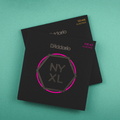A Beginner’s Guide To Guitar Slides
By Strings Direct – 29 August, 2023

Since the blues was first ‘discovered’ by W.C. Handy at the beginning of the 20th century, slide guitar has been a fundamental part of the genre. It was first used by a wide variety of Delta blues guitarists to create their haunting compositions. And later - players like Muddy Waters, Johnny Winter and Duane Allman electrified slide playing - using the slide to create a totally different set of sounds.
Even now, slide guitar playing remains popular - with guitarists like Derek Trucks, Joey Landreth and Ariel Posen all choosing to play slide.
If you want to follow in the footsteps of these guitarists and get started playing expressive slide guitar, the first step is to find the right guitar slide. As is so often the case when it comes to guitar gear, there is a lot of choice out there. And this can make deciding which slide to choose a little challenging when you are first starting out.
In this article then I will cover the key points you need to consider when buying a guitar slide. I will be looking at:
- The different materials from which guitar slides are made, and the impact these materials have on your tone
- The design of different guitar slides, and how this affects playability
- The thickness of your guitar slide and the impact this has on feel and playability
Without further ado then, let's get into it! Here are the key points that you need to consider before you buy a new guitar slide:
Material
The first point to consider is the material from which your guitar slide is made. In the early days of slide playing, guitarists used whichever materials were available to them. This included knives, bones and the necks of glass bottles. It is for this reason that slide playing is often referred to as 'bottleneck style'.
Today there is a wide range of different materials to choose from when looking at guitar slides. This includes those made from traditional materials like bone, brass and glass - as well as other materials like stone and carbon fibre.
The material that you choose for your slide is important, because it has a significant impact on your tone. As such, you need to choose a material that will work for you depending on your playing style and the tone you have in mind.
The most common materials used for slides are glass, metal and porcelain and ceramic. As such I will be focusing mostly on these materials in this article. Let's have a look at each of them in a bit more detail:
Metal
In the early days of the Delta blues, guitarists often used the blade of a knife or a flat piece of metal to slide up and down their strings. And metal has since remained a popular material for guitar slides.
Generally speaking, metal guitar slides have a bright and quite aggressive tone. They also have great sustain. As such, they have proven popular with guitarists looking for a more overdriven and fiery blues tone.
Muddy Waters was one of the first electric guitarists to use a metal guitar slide to achieve his searing slide tones. Notable slide players like Johnny Winter and Rory Gallagher closely followed his example. And in more recent years, Joe Bonamassa, Eric Sardinas and Joey Landreth have all used metal guitar slides to dial in their beautiful slide guitar tones.
So if you are looking for a heavier slide tone with more bite and treble, as well as great sustain, then a metal guitar slide could be a great choice.
Within the category of metal guitar slides, there are various different options. Amongst the most common of these are brass and steel. Steel guitar slides are also often coated in different materials; typically either nickel or chrome.
Broadly speaking, guitar slides made from brass have a slightly darker sound than those made from steel. Steel guitar slides sound a bit brighter, with chrome plated steel slides arguably sounding the brightest.

Metal guitar slides
There are a whole range of different metal guitar slides available out there. However some of the best options are as follows:
All of these will help you to dial in a searing, fiery blues tone that is perfect for heavier blues rock tones. However if you want to spend a little bit more and opt for either a boutique or signature guitar slide, then any of these slides would also make a great choice:
These slides all vary in weight, shape and size. And these are topics that I cover in more detail below. So before you make any decision, I would recommend deciding what you are looking for in those areas too. However, I hope that these initial options give you an idea of some of the different slides out there.
Glass
At the other end of the tonal spectrum are slides made from glass. Compared with slides made from metal, those made from glass produce a warmer and more mellow tone.
Over the past century, a wide range of notable slide guitarists have used glass guitar slides. This includes players like Bonnie Raitt, Sonny Landreth and Ry Cooder, amongst countless others.
It is arguably Duane Allman however, who is best associated with the glass guitar slide. He famously used a glass Coricidin medicine bottle for his slide. So the story goes, Allman started playing slide when his brother Gregg gave him two presents for his birthday. The first was a copy of Taj Mahal's debut album, featuring Mahal's version of 'Statesboro Blues'. The second was a bottle of Coricidin, because Allman had a cold.
Heavily inspired by Allman, Derek Trucks has also since gone on to use a glass slide. And with it he has earned a reputation as one of the best slide guitar players of all time. So if you are looking to recreate the tone of players like Allman and Trucks, opting for a glass guitar slide would be a great choice.

Glass guitar slides
Allman's legacy is such that many of the glass slides out there are designed in the style of his Coricidin medicine bottle.
If you are looking for a glass slide and you are interested in authenticity, then Dunlop offers the Derek Trucks Signature Slide. This is modelled precisely on Allman's Coricidin bottle. It is the same weight and is closed at the top. It also has the same indent at the bottom of the guitar slide where the lid for the medicine bottle would have originally been.
If you are looking for something in a slightly lower price range, then Dunlop also have a range of similar 'Blues Bottle Guitar Slides'. These are based on the same medicine bottle design, but come in a variety of different thicknesses (more on this below) and colours.
If you don't like the idea of using a slide with a closed top, then the good news is that there are a huge number of different glass guitar slides available. And they come in a range of different prices. Some of my top choices here are as follows:
All of these slides will help you to dial in beautiful, warm and mellow guitar tones that are perfect for the blues.
Porcelain & ceramic
Lastly, there are guitar slides made from porcelain and ceramic. These have tonal properties somewhere between metal and glass. As such, they are often recommended for guitarists who are looking for a compromise between glass and metal.
Porcelain and ceramic have only been used in more recent years in the manufacture of guitar slides. As such, their use within the blues genre is not as extensive when compared with slides made from glass or metal. Having said that, they have proven popular with a number of famous blues and blues rock guitarists.
Perhaps the most notable of these are Billy Gibbons (who also plays using a glass slide), Joe Perry and Keb' Mo'. Modern blues guitar players like Justin Johnson and Samantha Fish have also used ceramic guitar slides to brilliant effect.
Porcelain & ceramic slides
If you are looking for a guitar slide that is well balanced - both with regards to tone and playability - then a porcelain or ceramic slide could make a great choice. Some of the best options out there are as follows:
- Dunlop 246 Moonshine Ceramic Guitar Slide
- Dunlop 266 Mudslide Ceramic Porcelain Guitar Slide
- Billy Gibbons Mo-Jo Guitar Slide
- Joe Perry Boneyard Guitar Slide
Any of these slides would work well if you want a well balanced slide. And either the Billy Gibbons or Joe Perry slides would make great choices if you are also looking to recreate the slide setups of your favourite guitar players.
Size
Once you have decided on the material of your guitar slide, you next need to decide its size. The most important factor here is the size of the hole in which you place your finger. This will determine the control you have when using the slide, and also how comfortable it is to wear.
Typically, slides range in size from small to extra large. Some brands also offer a further variety of sizes beyond these simpler categories.
The key here is to strike a balance. You want to buy a slide that fits fairly snugly around your finger. This will give you more control and ensure it doesn't fall off your finger. However, you don't want the slide to be so tight that it is uncomfortable.
It is also worth noting that your finger will get warm and expand a little bit when you are wearing the slide. So if you envisage that you will be using it for long periods of time or whilst gigging, it might be worth opting for one that gives your finger a little more breathing space.
Length
The next consideration to make is the length of your guitar slide. And here you have three main options:
The first is to opt for a full length guitar slide, which covers the entirety of whichever finger you decide to wear it on. The benefit of this is that the slide will also cover all 6 strings of your guitar. So if you want to play chords using open tunings, or to move quickly between different strings, then a full length slide would make a great choice.
The second is to choose a shorter guitar slide. Unlike a full length slide, this will not cover your whole finger. Nor will it stretch across all of your guitar strings. At first this might sound like a drawback. But the shorter length of these slides makes them suitable for single string playing. And this means that if you are predominantly looking for a slide to play single string solos, then one of these shorter slides could be the way to go.
The final option is to choose a very short slide - or 'Knuckle Slide', as they are often called. These are generally much shorter than full length slides. The idea behind them is that they allow you to bend your knuckle. And this gives you the option to fret notes normally without having to work your way around the slide. So if you want to switch between ‘normal’ guitar playing and slide playing within the same song or in quick succession, one of these slides could work well.
As an aside, when you are deciding on the length of your slide, you need to consider the finger on which you will wear it. This is a lengthy topic that goes beyond the scope of this article. However the vast majority of players choose to wear their slide on either their third or fourth fingers. This keeps their first and middle fingers free to fret individual notes and play chords.

Wall thickness & weight
The final and significant element to consider when choosing a guitar slide, is wall thickness and its effect on weight.
As well as coming in a variety of sizes and lengths, guitar slides also come in a variety of thicknesses. These thicknesses are typically categorised as being light, medium and heavy. Again though, depending on the brand that you choose, you may be presented with further options.
As you might expect, guitar slides with 'heavy walls' are thick. And those with light walls are thin.
This is important, because the thickness of a slide has an impact on its weight. And this in turn affects both tone and playability.
Heavy guitar slides produce greater sustain. Like heavy gauge guitar strings, they also allow you to play more aggressively. You can apply heavy vibrato and create a range of sounds that are not possible with a lighter guitar slide.
The drawback to using a heavy slide is that they are more difficult to control. They place more strain on your fretting arm and require you to apply more effort to keep them in position. If you are playing with a regular action and have not increased it for your slide playing, then you will also have an increased chance of rattling the slide against your fretboard. Lastly, heavy guitar slides are more difficult to play at speed.
As such, the weight that works best for you will largely depend on your playing style and arm strength. If you are looking for soaring, sustained notes and you have a strong fretting arm, a heavy guitar slide could make a great choice. Conversely, if you want to play at speed, then a lighter guitar slide might work better for you.
Further considerations
In addition to the size and length of your guitar slide, there is also the design to consider. I have touched on some of the different slide designs above. However as you can see here, there are many different options from which to choose.
There are flared slides, concave slides and those which are essentially sawn in half. In this last design you have the option to either wear the slide normally, or turn it around so that it covers your knuckle, but leaves your fingertip free to fret as normal. Additionally, there is also a wide range of boutique guitar slides out there which come in a variety of different designs and shapes.
The suitability of these various slides will largely depend on personal preference and feel. And when you are just starting out, it can be difficult to establish what will or will not work so well for you.
As such, my advice to begin with is to try not to get overwhelmed by all of the different options. If in doubt, keep it simple. Start with a straight slide or one that has a gentle taper or concave. See how you get on, and you can then always adjust and experiment further down the line if you wish.
Closing thoughts
Part of what makes it challenging to choose the right guitar slide in the beginning, is that all of the elements listed here are connected, and they all have an impact on one another.
For example, glass guitar slides have a warm and more mellow tone. They are typically lighter in weight, and are therefore easier to control and play at speed.
By contrast, brass guitar slides have a more aggressive and sharper tone. They are typically heavier in weight, and are therefore a little more difficult to control. Yet they have longer sustain and arguably allow for a more aggressive style of vibrato.
In short then, you can view these two guitar slides as being at opposite ends of the spectrum, both with regards to their tone and playability. However, if we change some of the other parameters above, then this also changes.
For example, if the glass guitar slide is long and with a very heavy wall, its tone and playability will be closer to that of a brass slide. Equally, if the brass slide is short with a very light wall, its tone and playability will be closer to that of a glass slide.
Finding the right guitar slide might take a little bit of experimentation. You will quite likely need to try out some different slides in different materials to find what works best for you. When you are going through this process, let feeling and comfort guide you. On paper, a long, heavy walled glass guitar slide might seem like the obvious choice for your hand size and playing style. But if after repeatedly playing with it, you find it to be difficult and challenging, try something else.
Your guitar slide is what connects you to your instrument. So if in doubt, err on the side of comfort and playability. Don't get so wrapped up in the tonal properties of the different materials or in what you think you should be playing. If you are playing at your best, then you will be producing a great tone, and enjoying yourself. And that's what this is all about.
* * * * *
ABOUT THE AUTHOR

The Happy Bluesman
www.happybluesman.com
@happybluesman







